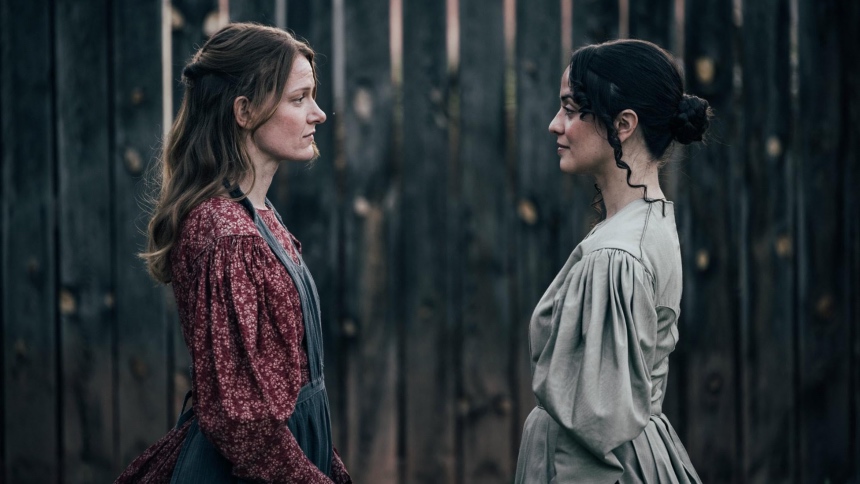Chattanooga 2025 Review: Four "Funsize Epics" Bring the Atmosphere and Ambiguity

The "Funsize Epics Vol. 1" shorts program at the Chattanooga Film Festival this year brings ten shorts over ten minutes to attendees. They're all interesting and worth checking out, but four in particular grabbed my attention.
The Angel (pictured at top), The Traveler, There Is No Antimemetics Division, and Parking Lot Seagulls are each beguiling in their own ways, yet they're brought together through their fantastic development of atmosphere within their brief runtimes and open-ended endings.
Within that group of four, there are two clear pairs. The Angel and The Traveler both take place in the 1880s, in Utah and New York, respectively. The former initially focuses the harsh landscape set to a moody ambient score to set a tone, while the latter uses its creaky, candlelit home to draw in the viewer.
There Is No Antimemetics Division and Parking Lot Seagulls are less firmly established in time and couldn't be more aesthetically different. There Is No Antimemetics Division takes place entirely in the walls of a retrofuturist building and is presented (mostly) in crisp black and white. Parking Lot Seagulls has an aggressive Super 8 filter and features purposefully shoddy visual effects overlays of the titular seagulls. Rather than any visual signifiers, it's their fascination with how our brains can, or cannot, hold onto things that tie them together.
The Angel, directed by Jess and Barrett Burgin, follows two Mormon plural wives, both pregnant, one more loved by their husband than the other. When the first wife (Tatum Langton, the characters are not named) has a vision of what she believes is an angel at a nearby watering hole, she hurries to share the experience with the second wife (Jessica Staples). Of course things aren't so simply miraculous as they'd hoped, and the angel (the great Doug Jones in a rare non-makeup performance) demands the blood of their husband.
It's easy to guess that The Angel is a proof of concept for a feature, given that it introduces more ideas than it has time to fully dive into. Yet it doles out those ideas, about polygamy, sacrifice, faith, isolation, and maternal impulses so well, that it serves as a hell of a hook for a feature.
The Traveler is another proof of concept, one that's ending is such a strong, unique hook I won't even approach giving it away here. What makes it special, though, is what's familiar about it. The short centers on widow Hannah (Natalie Knepp) in the days after her husband's death as a supernatural entity enters her home. As Hannah hears some bumps in the night and picks up a candle to investigate, The Traveler proves, as the best gothic ghost movies do, that all you need for an effective horror sequence is an old house with creaky floorboards and a woman walking around with a candle. Writer/director Matthew Scheffler also tracks her movement and sight-lines with the camera, smoothly establishing an identification with her that's helped by Knepp's affecting performance of desperation to see her husband again.
There Is No Antimemetics Division is an adaptation of the short story We Need To Talk About Fifty-Five, originally published by the author known as qntm to the SCP Wiki, a collaborative writing project with various stories of all kinds related to the SCP Foundation, which seeks to "Secure, Contain, Protect."
Adapted from the story by screenwriter/director Adria Lang, the film throws viewers headfirst into a tense meeting between Marion (Jasika Nicole) and her boss Brent (Neil Napier). It's tense because Brent says he doesn't know who Marion is or how she got the level of clearance she has, so she must be a spy.
But Marion assures him she's not; she says she works in the Antimemetics Division, a division Brent is sure doesn't exist. Which makes perfect sense because that's how antimemetic ideas work, they are inherently impossible to spread, as Marion says at one point "these things are redaction incarnate." There Is No Antimemetics Division looks great and is well acted by Nicole, Napier, and Mateus Ward as Brent's bodyguard. But the real star of the show is Lang's script, which perfectly balances the thrills of uncertainty about Marion's fate and its explanations of the fascinating abstractions at the center of the conflict.
On the other hand, Parking Lot Seagulls doesn't really have any thrills or conflict to speak of. The film follows an unnamed character played by Christopher Whitehead from one place to another as he talks to the camera about various things, including his missing friend T. Things start in an empty parking lot with the aforementioned poorly overlaid seagulls, before moving to a pawn shop, a grocery store, under a bridge, a convenience store, a payphone, and other spaces.
He's an awkward guy. who at one point eats a bait worm and at another sings Gollum's "to catch a fish, so juicy sweet!" song from The Two Towers. Spending time with him is equally unnerving and sad, as we do want this weirdo to find his friend. We also hear about T from some other people who say they haven't seen him for a while, and one woman who says she saw him getting a wrong bus.
As the short goes on, though, the reality of T becomes less and less certain. Parking Lot Seagulls is just wonderfully strange, and its more indirect, almost vibe-forward questioning of reality makes it a very nice program sibling to There Is No Antimemetics Division.
You can rent the Funsize Epics Vol. 1 shorts program here.







